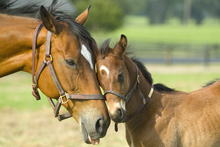The first few hours of the relationship between mare and foal are extremely important for bonding. Mares and foals are typically in close proximity to each other during the first days and weeks of life. Horses are considered a follower species, and like to keep their foals nearby at all times, in contract to animals such as deer, which are part of a hider species that tends to stash their young in hiding places and leave them for periods of time while grazing.

Bonding between mare and foal
The first few hours of the relationship between mare and foal are extremely important for bonding, and mares and foals are typically in close proximity to each other during the first days and weeks of life.
In the bonding process, vision and olfactory senses are important for recognition of both mare and foal. Certain actions occur during the first few hours following parturition and are critical for the mare to recognize her foal selectively.
Maternal behavior can begin immediately following parturition to one to three hours after labor. The mare will begin to shed the placenta, nuzzle, lick, nurse, and encourage the foal to stand up.
The mare will stand 15 to 20 minutes after giving birth and begin to lick the amniotic fluid off the foal and nuzzle the foal.
Licking is one of the first signs of mare/ foal bonding. This is important in stimulating, encouraging, and drying the foal.
Nudging is another form of bonding between the mare and foal. The mare encourages the foal to stand and directs the foal to the udders by doing so.
Maiden mares often have a more difficult time adjusting to a nursing foal. The mare may squeal and not let the foal nurse well. You may need to offer her some reassurance and restrain her to allow the foal to nurse.
Foals usually take about a week to recognize their dams and may follow any large, moving object in the meantime.
The mare and foal will soon recognize each other by vocalizations. This is important if the foal is separated from the herd. The mare will vocalize and the foal will go toward the mare's call.
Once foals are one or two months old, they begin to engage in play and mutual grooming with other foals. These activities teach foals social structure, as fillies tend to bond with and groom other foals, while colts tend to do less mutual grooming.
Foals should be full of energy and nurse with vigor and frequency. If your foal seems dull or lethargic, it is an emergency and may indicate serious illness. Call your veterinarian with any questions and concerns. He or she may need to perform a thorough mare and foal exam and can offer support as you and your mare welcome this new life into the world.
Learn more about Care of Your Foal
